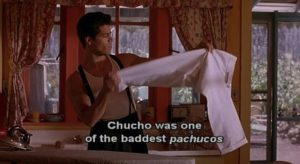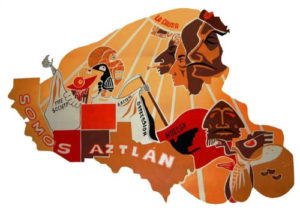In this week reading of Next of Kin we read about the film industry and a lot about Joaquin and being the first Chicano poem and film. What caught my attention in this reading was Sylvia Morales ideas, and thoughts of the exclusion of women in Chicano history. “Chicana” by Sylvia, Morales has different approach to the meaning of Chicano, it’s Chicana.
I took an interest on this topic, it made me think back, and try to recall a history book (besides college) that would include Chicana’s in History. The film begins to explain the root of women’s history and how it ties to Mexican culture. And how that ties into our culture here in the United States and the Chicana’s. Her film is still pictures of all types of women, working, stay-at-home etc. But Morales also mentions activist like Francisca Flores, Alicia Escalante and Dolores Huerta. She acknowledges that there can be two types of women, but none is better or worse than the other.
Morales goes on with mentioning patriarchy, and how it ties with the women of these times. In the film there were no men mentioned or involved. All these women stood alone, which represented absence of a man, and the need of no man. She goes into Mexican revolution era, and the demand for full right citizenship and independent economic based rather than dependence on marriage for survival. There was no need to have women only have economic stability to get married. It wasn’t and isn’t fair that women would only have a steady income through their marriage. This radical thinking is the reason why women like others and myself, have the opportunity to go to school, have a career and be independent.
From reading this part of this chapter, made me reflect a lot of women and our history. We learn in high school about the Civil Rights Movement, and may even watch films like “Walk Out”, but we never really have information about radical women involved in the movements. As a college student, I had never heard of Cherrie Moraga, or Angela Davis. Why is it that women that influenced us today are only mentioned in Chicano/a classes or in Women’s Studies? Chicana women influenced our times regardless whether you’re African America, Latina, Chicano/a, Asian or White. The Civil Rights Movement, The Women’s Movement, the Chicano/a movement and all movements, have affected our lives. And to go with all the movements there weren’t only men behind these movements but women as well. Strong women who had their own ideas and what they believed to be fair for all women. This patriarchal system embedded amongst Latinos marginalized strong women to be part of our History books.
This chapter motivated me (as you can read) to really reflect on my history as a Latina and to be first generation. There were so many women who impacted our lives and I agree with Sylvia Morales, that there is not enough women written down in history in regards to Chicano/a history. The message in regards to patriarchal system rising from years ago in Mexico, is also an affect that women took on and also brought on to the America.


 The readings of this week focus on the representation of Chicano/a families in the media. The readings talk about how Chicano/a families are portrayed on television and in movies. Of the two readings I found Chapter 2 “Shooting the Patriarch” of Next of Kin by Richard T. Rodríguez to be the one to catch my interest the most. I found this reading to be interesting because I felt there was an emphasis on recent representations of the Chicano/a family.
The readings of this week focus on the representation of Chicano/a families in the media. The readings talk about how Chicano/a families are portrayed on television and in movies. Of the two readings I found Chapter 2 “Shooting the Patriarch” of Next of Kin by Richard T. Rodríguez to be the one to catch my interest the most. I found this reading to be interesting because I felt there was an emphasis on recent representations of the Chicano/a family.
